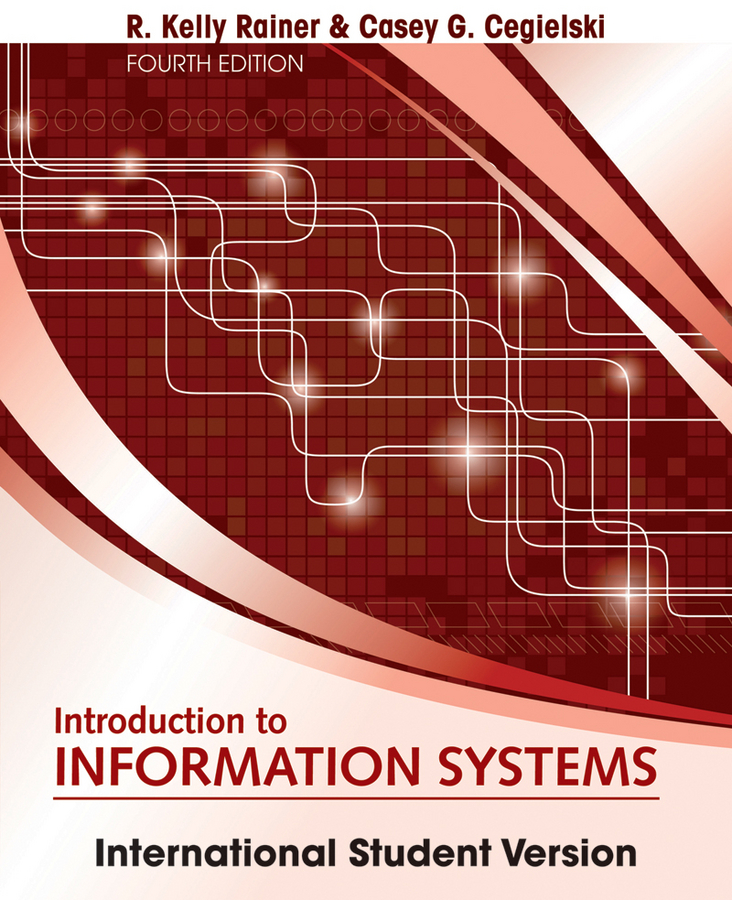
Rainer & Cegielski's new edition of Introduction to Information Systems: Enabling and Transforming Business includes updated coverage, refined cases, more illustrations, and a new "Weekly Updates" resource. Its concise chapters, many cases and examples, and online quizzing provide smooth and straightforward information and provide many hands-on activities. In general, the text is more engaging, compelling and relevant with a broader table of contents, pedagogically innovative structure, integrated activities, Excel and Access projects,and integration with WileyPLUS. INDICE: Chapter 1 The Modern Organization Functioning in a Global Environment1.1 Why Should I Study Information Systems?1.2 Overview of Computer-Based Information Systems1.3 How Does IT Impact Organizations?1.4 Importance of Information Systems to SocietyChapter 2 Information Systems and the Modern Orgnization2.1 Business Processes2.2 Business process reengineering and business process management2.3 Business Pressures, Organizational Responses, and InformationTechnology Support2.4 Competitive Advantage and Strategic Information Systems2.5 Business - Information Technology AlignmentChapter 3 Ethics and Privacy3.1Ethical Issues3.2 PrivacyChapter 4 Information Security4.1 Introduction to Information Security4.2 Unintentional Threats to Information Systems4.3 Deliberate Threats to Information Systems4.4 What Organizations Are Doing to Protect Information Resources4.5 Information Security ControlsChapter 5 Managing Knowledge and Data5.1 Managing Data5.2 The Database Approach5.3 Database Management Systems5.4 Data Warehousing5.5 Knowledge ManagementChapter 6 Networks6.1 What Is a Computer Network?6.2 Network Fundamentals6.3 The Internet and the World Wide Web6.4 Network ApplicationsChapter 7 Electronic Commerce: Applications andIssues7.1 Overview of E-Business and E-Commerce7.2 Business-to-Consumer (B2C)Electronic Commerce7.3 Business-to-Business (B2B) Electronic Commerce7.4 Electronic Payments7.5 Ethical and Legal Issues in E-BusinessChapter 8 Wireless Technologies and the Modern Organization8.1 Wireless Technologies8.2 Wireless Computer Networks and Internet Access8.3 Mobile Computing and Mobile Commerce8.4Pervasive Computing8.5 Wireless SecurityChapter 9 Web 2.0 and Social Networks9.1 Web 2.0 Underlying Technologies9.2 Web 2.0 Applications9.3 Categories of Web 2.0 SitesChapter 10 Information Systems that Support Organizations10.1 Transaction Processing Systems10.2 Functional Area Information Systems10.3 Enterprise Resource Planning Systems10.4 ReportsChapter 11 Customer Relationship Management and Supply Chain Management11.1 Defining Customer Relationship Management11.2 Operational Customer Relationship Management Systems11.3 Analytical Customer Relationship Management Systems11.4 Other Types of Customer RelationshipManagement Systems11.5 Supply Chains11.6 Supply Chain Management11.7 Information Technology Support for Supply Chain Management Chapter 12 Managerial Support Systems12.1 Managers and Decision Making12.2 What Is Business Intelligence?12.3 Business Intelligence Applications for Data Analysis12.4 Business Intelligence Applications for Presenting Results12.5 Business Intelligence in Action:Corporate Performance ManagementChapter 13 Acquiring Information Systems and Applications 13.1 Planning for and Justifying IT Applications13.2 Strategies for Acquiring IT Applications13.3 The Traditional Systems Development Life Cycle13.4 Alternative Methods and Tools for Systems Development13.5 Vendor and Software SelectionTechnology Guide 1 Hardware TG 1.1 IntroductionTG 1.2 StrategicHardware IssuesTG 1.3 Computer HierarchyTG 1.4 Input and Output TechnologiesTG 1.5 The Central Processing UnitTechnology Guide 2 Software. TG 2.1 Introduction to SoftwareTG 2.2 Software IssuesTG 2.3 Systems SoftwareTG 2.4 ApplicationSoftwareTechnology Guide 3 Emerging Types of Enterprise ComputingTG 3.1 IntroductionTG 3.2 Server FarmsTG 3.3 VirtualizationTG 3.4 Grid ComputingTG 3.5 Utility ComputingTG 3.6 Cloud ComputingTG 3.7 Emerging Software TrendsTechnology Guide 4 Intelligent Systems TG4.1 Introduction to Intelligent SystemsTG4.2 Expert SystemsTG4.3 Neural NetworksTG4.4 Fuzzy LogicTG4.5 Genetic AlgorithmsTG4.6Intelligent AgentsTechnology Guide 5 Protecting Your Information AssetsTG 5.1IntroductionTG 5.2 Behavioral Actions to Protect Your Information AssetsTG 5.3 Computer-Based Actions to Protect Your Information AssetsGlossary Index
- ISBN: 978-1-118-09230-9
- Editorial: John Wiley & Sons
- Encuadernacion: Rústica
- Páginas: 480
- Fecha Publicación: 21/05/2012
- Nº Volúmenes: 1
- Idioma: Inglés
